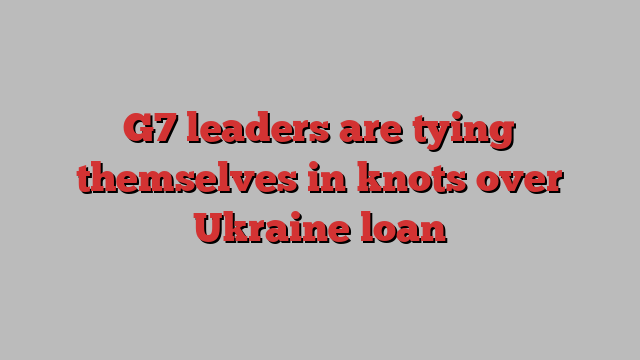
Stay informed with free updates
Simply sign up to the War in Ukraine myFT Digest — delivered directly to your inbox.
Ukraine has won itself some breathing room — on the battlefield with its Kursk offensive, and financially through a debt restructuring deal with private investors. But now, the amount of financial resources Kyiv can count on to ensure the country’s survival hinges on a strangely contorted discussion between western allies.
It concerns how to financially engineer a $50bn advance on money relating to Russian central bank reserves that western jurisdictions have blocked Moscow’s access to. In June, G7 leaders committed to “extraordinary revenue acceleration loans”. After earlier unedifying hold-ups of funding packages on both sides of the Atlantic, this was presented as proof that the west could still stand up for Ukraine and make Russia pay for the country’s destruction.
Don’t be too impressed. The very need for a financially engineered loan betrays both an unseemly quest for alternatives to western taxpayer funding and the continued refusal to enforce Russia’s obligation to compensate Ukraine by transferring its immobilised assets outright. In this sense, the commitment at the Puglia summit was a sign of timidity not confidence, even if $50bn from whatever source is a whole lot better than nothing.
But even that remains far from a done deal, with technical difficulties reflecting deeper political challenges.
The idea is for a syndicate of Ukraine’s friends to take up a loan, then channel it through a trustee institution such as the World Bank. Kyiv’s resulting debt-service costs would be covered by the extraordinary profits that Euroclear, the Belgian securities custodian, is making on nearly €200bn of cash balances it is prohibited from paying out to Russia’s central bank.
These war profits (which is what they are, through no fault of Euroclear’s) ought morally to go to Ukraine anyway, which is why the EU recently decided to channel much of them to military aid. The new G7 plan is essentially to repurpose and “accelerate” this profit stream into a big upfront cheque.
That is enough to show the G7 is granting no additional money beyond what Ukraine was already rightly set to receive, let alone any belonging to Moscow. The scheme is already being used to argue that less needs to be spent by western governments themselves — witness Berlin’s shameful plan to cut aid for Ukraine.
G7 leaders left it to technocrats to make good on the political promise, such as it is. But important technical hurdles are far from cleared. The main function of securing the loan with future profits from holding Russian state assets is to make the loan as risk-free as possible for western Treasuries — at least risk-free enough not to have to get lawmakers’ approval, especially in the US Congress. It is also politically opportune to make more western countries take part than just the EU, where the money for debt service is generated. The flip side is that Kyiv’s indebtedness will increase, even if securitisation supposedly means it never has to pay anything.
But the EU only renews its sanctions for six months at a time, so that profit stream could cease as soon as a single member state vetoes renewal. That brings risk not just for non-EU members in the scheme but also Kyiv: a contingent fiscal liability could complicate the IMF’s debt sustainability judgments. To address this, Brussels has presented EU governments with options that include longer renewal periods or tying the end of the asset block to Moscow compensating Kyiv.
The former would require Hungary to relinquish its twice-yearly veto power. The latter would be tantamount to the confiscation so strongly feared by Paris, Berlin and the European Central Bank. Neither option seems likely to gain unanimity. In any case, it is hard to see how the loan documents can avoid recourse to something more than the profit stream in case Russia miraculously returns to international good standing sooner than expected — and regains access to its reserves.
In a nutshell, the problem is that western leaders have tried to get something for nothing: new funding for Kyiv, but with no new taxpayer commitments, no financial risk and no seizure of the assets even of a criminal state. These political contradictions cannot be solved, at most they can be camouflaged, by technocratic solutions.
Only a political choice to set a new legal precedent would cut through this Gordian knot: a transparent decision to jointly confiscate Russia’s assets outright for Ukraine’s benefit. It may still come to that as political contradictions become unsustainable. But the longer it takes, the more is lost in waiting. In the meantime, making good on the Puglia promise would be welcome — but no one should imagine that will close the issue for more than a few months.